Term archive
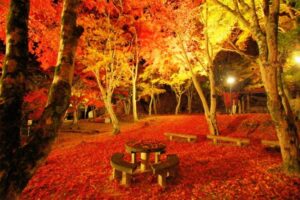
投稿タイプ:sightseeing
Mt. Kasagi / Kasagi-yama Maple Park
Mt. Kasagi in Kasagi rises 288 meters about the south bank of the Kizu River. It is home to many strange and mysterious rock formations giving it the nickname “Megalith Theme Park” and is designated as a historic scenic spot in Japan. Although it is not an easy hike, anyone with average ability can reach the top and enjoy the spectacular views.
From the top of the mountain, it looks like you are on an island floating in a sea of clouds. The view from the top of the mountain was a popular place to moon gaze during the Edo Period. The view is particular spectacular during the autumn season when the entire 3,000 sq. meter river valley is covered in carpet of red maple leaves
Mt. Kasagi is of great historical significance. It is home to a Shingon Buddhist temple of the Chisan School with historic connections to Todaiji on nearby Nara. Famous monks such as Jokei have lived at the temple and Yamabushi, or warrior hermits said to be imbued with supernatural powers, are said to have trained here; making it an important part of Japanese Buddhist history. What’s more, in the late Kamakura period (1185–1333), it was also the stage of foiled plot kill the shogun by the 96th Emperor Go-Daigo.
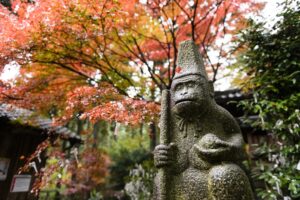
投稿タイプ:sightseeing
Sarumaru Shrine
The shrine is dedicated to Sarumaru Dayu, who was a traditional waka poet. One of his famous poems was included in Hyakunin Isshu (a classical anthology): “Autumn at its saddest - Rustling through the leaves and moving on alone deep into the mountains, I hear a lonely stag belling for his doe.” Currently, the shrine's deity is widely worshipped as a deity "to remove bumps" and “to prevent cancer." The shrine's monthly festival is held on the 13th of every month, and the main festival (Taisai) on April 13th and September 13th. The fire festival will be held on June 13th and December 13th.
Autumn leaves around the temple grounds turn red in late November, a sight which is well worth seeing.
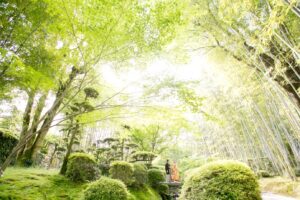
投稿タイプ:sightseeing
Shokado Garden Art Museum
Shokado Garden Art Museum is associated with Shokado Shojo (1584-1639), who was a buddhist priest from Iwashimizu Hachimangu Shrine.
Shokado Garden has an area of approximately 20,000㎡, and the Soan Shokado, where Shojo lived after his retirement (currently closed to visitors due to the earthquake of June 18, 2018). The garden is also home to three tearooms, Sho-in, Chiku-in, and Bai-in. In the garden, in addition to more than 40 kinds of bamboo and nearly 200 camellia trees, plum trees, cherry trees, green maple trees and Japanese maple trees can also be found, creating beautiful scenery across all four seasons.
Shokado Art Museum has special exhibitions held in spring and autumn each year, and exhibitions focused on the museum collections around three times a year.
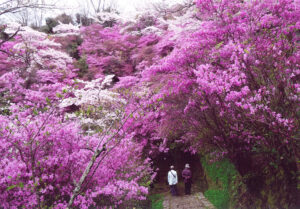
投稿タイプ:sightseeing
Jindo-ji Temple
Located in the mountains of the Tea infused region of Kyoto, just outskirts of Kizugawa city, Jindo-ji Temple is home to a many hidden treasures. The grounds turn various shades of pink and purple with cherry blossoms and azaleas which form a tunnel of flowers over the stone steps leading up to the bell tower in spring. The temple also houses numerous important cultural properties which can be seen via a guided tour with a priest.
Jindo-ji is said to have been built by Prince Shotoku in 596 and later prospered as a dojo for the Shugendo School of mountain asceticism. The mountain where it resides once was home to many temples but all were burned down in a fire with only Jindo-ji being rebuilt in 1406. It is said that the main statue of the temple was carved when the founder of Shugendo, En no Gyoja, while he practiced on the mountain.
Including the main hall (Zao-do), built in the Muromachi period, there are six important cultural properties in the storage: the wooden Fudo Myo-ou statue, the wooden Aizen Myo-ou sitting statue, the wooden Amida Nyorai sitting statue, the Bishamon Ten standing statue, the Nikko Bosatsu statue, and the Gekko (Moonlight) Bodhisattva statue.
It is recommended you walk to the temple from Tanakura station on the JR Nara line so you can enjoy the view of the tea fields and refreshing mountain air.
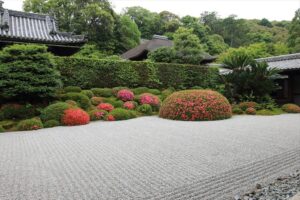
投稿タイプ:sightseeing
Ikkyu-ji Temple
Ikkyu-ji Temple was restored under the order of Ikkyu Sojun, a Japanese Zen Buddhist priest, who is widely known in Japan as having been quite witty, and thus the subject of many interesting stories. The temple has a garden, known as “Hojo Garden,” designated as a place of scenic beauty, as well as the main hall building, designated an Important Cultural Property. The Hojo Garden consists of a North Garden, East Garden, and South Garden, each of which has a different atmosphere and particular type of beauty. At the temple, visitors can enjoy traditional shojin vegetarian cuisine, as eaten by Japanese Buddhist monks, with dishes such as “Shojin Tenshin" (a light vegetarian meal), “Shojin Makunouchi" (a vegetarian box lunch), and “Shojin Honzen" (a full-course vegetarian dinner). Ikkyu-ji Temple’s original natto (fermented soybeans) are also popular as a souvenir from the temple. Traditionally, making the natto is one of the tasks for the temple’s incumbent chief priest.
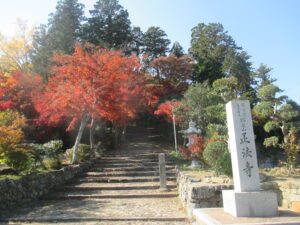
投稿タイプ:sightseeing
Shoho-ji Temple (Wazuka-cho)
The temple is believed to have been established by the monk Gyoki in order to console the spirit of Prince Asaka, son of Emperor Shomu.
Ginkgo and maple trees are planted throughout the approach on the temple grounds, and their autumn leaves give a festive atmosphere to the normally quiet old temple.
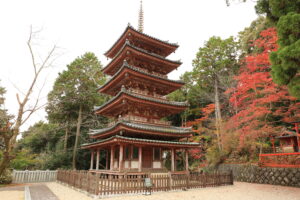
投稿タイプ:sightseeing
Kaijusen-ji Temple
Legend has it that Fujioyama Kannonji Temple was founded in 735 when Emperor Shomu ordered a Buddhist monk to enshrine the Eleven-faced Kannon Bodhisattva in order to pray for the safe construction of the Great Buddha statue.
Unfortunately, the temple was burnt down in 1137. In 1208, Jokei, a monk of Kasagidera Temple, moved to the abandoned site of Kannonji Temple, and built a hermitage for training. The place was renamed Fudaraku-san Kaijusen-ji Temple and was revived.
The five-storied pagoda, which is 17.7 m high and painted in red, is a precious relic of the Kamakura period, thus designated as a national treasure of Japan. Other treasures of the temple include the main deity statue of the Eleven-faced Kannon Bodhisattva, the Monjudo hall, the colored Hokke Mandala painting on silk cloth, and Kaijusen-ji Temple’s documents, all of which are designated as important cultural properties.
In the grounds, there is an “Eggplant seat” said to fulfill your wishes when you sit on it, and a huge Yamamomo tree selected as one of the “200 Natural Views in Kyoto”. The autumn foliage here is beautiful and you can enjoy looking out at the Kunikyo Palace and Heijo Palace from the altitude of 200 meters while also enjoying the maple leaves.
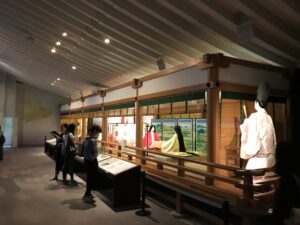
投稿タイプ:sightseeing
The Tale of Genji Museum,Uji City
Known as a masterpiece in classical Japanese literature, "The Tale of Genji" tells the story of an extremely handsome nobleman and his love affairs in Heian period (794-1185), and the final 10 chapters take place in Uji City. This museum presents explanations, movies, and interactive games available in English, making it a lot of fun to experience the glamorous world of Genji.
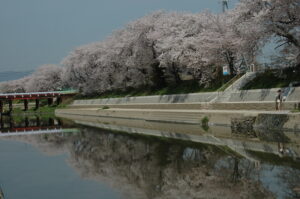
投稿タイプ:sightseeing
Cherry Blossoms Along the Maekawa Embankment
The Maekawa Embankment in Higashi-imoarai is famous for its cherry blossoms, mainly of the Yoshino cherry variety. The cherry trees reach full bloom during the period from the end of March to early April all around the embankment. The cherry blossoms lit up by paper lanterns at night is also beautiful.
This location has been selected as one of the 200 selected Natural Treasures of Kyoto.
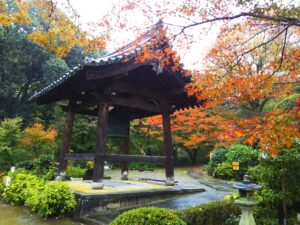
投稿タイプ:sightseeing
Jinno-ji Temple
This temple was established by the monk Gyokyo, who is said to have transferred a spirit seperated from Iwashimizu Hachimangu Shrine to this temple. Visitors can enjoy brilliant autumn leaves along the approach to the temple grounds. The gingko trees are also gorgeous.
*Reservations are required for entrance to the Main Hall.
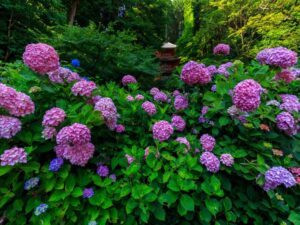
投稿タイプ:sightseeing
Gansen-ji Temple
Gansen-ji Temple is an ancient Buddhist temple located in Kamo-cho, part of Kizugawa City in the southernmost part of Kyoto Prefecture. Thought to have been built in 729, the name "Gansen-ji" translates literally to "Rock Boat Temple" and near the entrance of the temple’s main gate is a boat-shaped rock, where legend has it that priests used the rock for sacred cleansing rituals. Nestled in the pristine nature of Kyoto's tea producing region, the three-storied pagoda on the temple grounds is a designated Important Cultural Property and the main hall maintains an ancient yet elegant charm. Gansen-ji Temple is famous for its displays of bright hydrangeas, water lillies, and crape myrtle flowers in the summer. Gansen-ji is truly a sight to see in any of the four seasons, though, with Japanese plum and cherry blossom trees blooming in the spring, autumn foliage, and camelias in the winter.
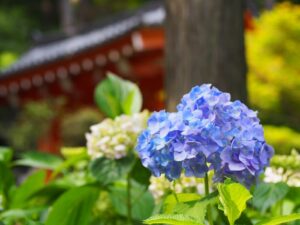
投稿タイプ:sightseeing
Mimuroto-ji Temple
Mimuroto-ji Temple is known for its spectacular gardens, and it is sometimes called the "Temple of Flowers." Mimuroto-ji is located in Uji City, part of Kyoto's tea-producing region in the south of Kyoto Prefecture. From late April to early May, you can find a sea of some 20,000 azaleas—one of the best displays in the Kansai region—and wander through the garden paths to surround yourself with the flowers. Opposite the azalea gardens are approximately 10,000 hydrangeas that begin to blossom in June, surrounding visitors with magnificent shades of pinks and blues. Finally, as you get closer to temple's main hall, you'll find a huge display of lotus flowers which bloom in all shades of pink and white from late June to early August. Make the most of the flowers by taking a rest at the tea house inside the temple grounds. Take in the pond and dry rock gardens, and of course the Buddhist statues, which are designated Important Cultural Assets.